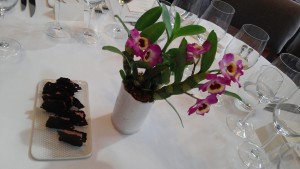There are few sweet wines more beloved than those produced in Sauternes within Bordeaux. Some wine drinkers liken Barsac (Sauternes) to “liquid gold,” given its rich golden hue and silky and slightly viscous texture. Barsac (Sauternes) are prized for their complex floral and herbal aromas, concentrated ripe, citrus, stone or tropical fruit, and honey notes, and long velvety finish. And within Sauternes, Château Climens in Barsac produces some of the finest in the region.
This over five-century-old, family owned, biodynamic “First Growth” vineyard, received Bordeaux Classification in 1855, and produces some of the finest Premier Cru Barsacs from 100 percent botrytized Sémillon grapes. Botrytized grapes are those that have been infected with noble rot. This occurs when a microscopic fungus known as Botrytis Cinerea develops on the surface of ripening grapes while they remain on the vine, causing the grapes to secrete molecules in an attempt to combat this microscopic fungus. These molecules also give wines their rich aromas during the vinification process. Noble rot causes an increase in the amount of sugars and acid that are contained within an affected wine grape. As a result, the wines produced from botrytized wine grapes under the right conditions tend to be fragrant, sweet and complex. Château Climens selects only the best Sémillon each year for its Grand Cru Barsac. If a harvest falls below the Vineyard’s designated standards of quality no vintage is created. Nor are half bottles produced. Unlike many other vineyards in Sauternes, Château Climens makes only 750ml bottles. Moreover, the barrel fermentation process is as meticulous as the one used during grape selection at harvest time. The pressed grapes are allowed to naturally ferment and maturation begins to take place on the lees (with the wine remaining in contact with the yeasts). This minimally artificially invasive process maximizes the floral aromas and lively fruit notes that will eventually come from the wine produced.
Château Climens also vinifies its grapes in small batches giving winemaker Berenice Lurton greater control over the fermentation process. Furthermore, the maturation process extends over twenty months. The younger vintages tend to be floral, fruity and bright, while the older vintages have herb, sweet spice and honey as well as dried and preserved citrus, stone or tropical fruit characteristics.

Fine Château Climens vintages were paired with equally superb organic, locally grown and sustainable cuisine on March 19, 2016 at Blue Hill at Stone Barns. The three course lunch pairing proved that Barsac (Sauternes) are not only ideal as digestifs but also as wine complements to a variety of different foods and flavors.

For starters, a Cypres de Climens, 2013 (the Vineyard’s first biodynamic vintage) paired wonderfully with a pork liver terrine. The citrus fruit flavors and mild touches of cool mint in this vintage balanced the concentrated richness of the creamy pork liver.
On the flipside, a duo of Château Climens 2011 and 2012 enhanced the light and delicate flavors of a winter squash salad with golden raisins, strained yogurt and toasted almonds, and added a touch of honey sweetness and peach, apricot and tropical fruit freshness to complement the mild nuttiness of the dish.

A Château Climens 2009 and 2005 were perfect selections for a tender Stone Barns Berkshire Pig with rutabaga, dates and charcuterie sauce as well as spinach. The subtle sweet spice and ripe tropical fruit, melon and citrus fruit flavors of these vintages complemented this subtly pungent roasted dish.




Be First to Comment